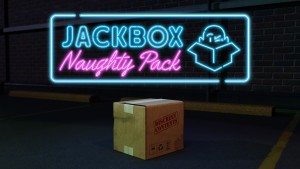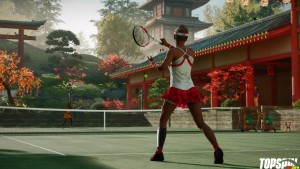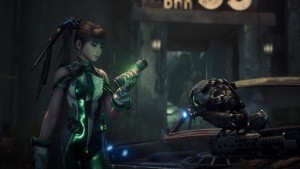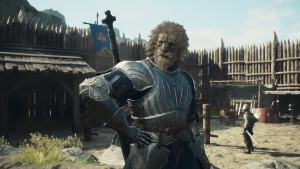Please support Game Informer. Print magazine subscriptions are less than $2 per issue
A Guided Tour Through Star Fox Zero

Shigeru Miyamoto greeted a room full of journalists following a private screening of this year's E3 Nintendo Direct to discuss Star Fox Zero's gameplay functionality on Wii U. He began his talk with the enthusiastic smile we've seen every year he's taken the stage to introduce a new Nintendo surprise. "I've been making games for about 35 years," Miaymoto said. "I'm not tired of it. I still love making them. It's my favorite thing."
During the Nintendo Direct presentation, we learned Miyamoto drew inspiration for Star Fox from Japanese culture, specifically the arches at Fushimi Inari Taisha shrine, and the marionette-led science-fiction TV show, Thunderbirds. Interestingly, the show combines marionette puppets and special effects using a filming technique called "Supermarionation."
Miyamoto talked a little about his time with Star Fox, and then introduced two people he works closely with on the project: Yugo Hiyashi, who was in charge of development of The Legend of Zelda: Twilight Princess and Wii Fit U now serves as Star Fox Zero's director, and Yusuke Hashimoto of Platinum Games and Bayonetta 2 fame is helping design the project. Hashimoto didn't join Nintendo; Star Fox Zero is co-developed by Platinum Games. Hiyashi said Star Fox is a new genre for him, and Hashimoto made it clear Star Fox Zero is nothing like Bayonetta, but did say he's known for big action scenes and wants that element to be in Star Fox Zero. Hashimoto noted that he added the Arwing to Bayonetta 2, and teased that it may have been the connective tissue that brought him to Star Fox Zero.
The three developers talked openly with each other as they detailed Star Fox Zero's unique two-screen gameplay functionality – which presents a familiar third-person perspective on the TV, and a view from the Arwing's cockpit on the gamepad. The player is tasked to keep tabs on both to better survey the battlefield and use them strategically to down enemy ships in on-rails and free-flying environments.
Hiyashi grabbed a Wii U gamepad to give us a look at one of the earlier stages on the familiar planet Corneria. The first shot is of outer space. We see Fox McCloud in his Arwing in formation with the Great Fox of Star Fox Command. He's joined by a squadron of familiar faces: Falco Lombardi, Slippy Toad, and Peppy Hare. The crew receives orders from General Pepper. As he barks out the mission details, Hiyashi aims the gamepad at Slippy and fires.
"Don't shoot Slippy," Miyamoto said with a laugh.
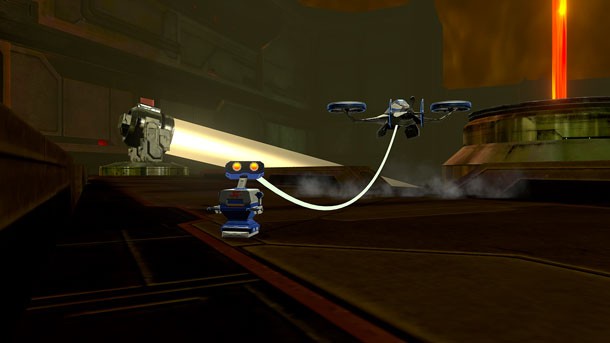
Fox's first task is to check in on his teammates. This action is handled by looking at their vessels through the gamepad. Once the team is ready, they rocket down to the planet's surface, the atmosphere turning to flames as they descend. Corneria comes into view with the lush green and blue details we've seen in the past, almost looking like rains are common on this planet. Fox and his crew soar over an ocean for a split second before being engaged by enemy vessels.
First there are oddly shaped enemy aircraft in a squadron of three, which are downed with ease by Hiyashi. Next up are giant blades that rise from the ocean. They can be targeted and destroyed with lock-on blasts, but Hiyashi doesn't move quickly enough to defeat them before they take attack positions. They rotate and slow in momentum, creating obstacles that need to be navigated quickly, either by flying closely along the ocean's surface, or spinning out of the way to the left or right. The level is filled with familiar looking arches, opening gates, skyscrapers, and low-hanging bridges. Hiyashi ducks in and out of all of them. The stage is new, but is a clear love letter to the Nintendo 64 game, Star Fox 64.
Miyamoto says that the game is directly inspired by that entry in the series, but was quick to point out that they also looked at Star Fox 2, the Super Nintendo game that completed development, but never released.
Hiyashi showed the connection to Star Fox 2 by transforming the Arwing into its Walker form. The Walker looks like a chicken with two legs, sharp claws, wings pulled back, and a head with a pointy beak. The walker gives Fox a more defined vantage point for taking down targets, but is obviously slower and more vulnerable to attack. The Walker can hop, dash, and roll away from attackers when not in a position to lay waste to numerous clumped targets at once.
The demo consisted of all of the staples from Star Fox 64: gold and silver rings, laser power-ups, collapsing structures, a wide variety of enemies, and what would appear to be multiple paths or divergent objectives, though Nintendo didn't highlight them.
The action is varied and intense. It doesn't take long for Slippy to have two bogeys on him, and he cries out to Fox for help. Hiyashi pursues Fox's attackers, blasting through a waterfall to give chase and save his friend.
The demo ends with an open flying sequence in which a tower must be protected from new enemies called striders. The striders are slow moving mechs, with four long spider legs. If they climb to the top of the tower, the game is over. Fox is tasked to down enemy fighters, while dealing with this threat from all vectors. The striders' only weakspot is on their top, which forces Hiyashi to fly over top of them and aim his gamepad down to shoot the exposed, glowing hit zone.
A few striders attach themselves to the building, but they move slowly and pose no real threat. This environment is relatively small, but offers plenty of maneuverable space for the Arwing to swing around or somersault to engage the strider onslaught.
Once the building is cleared of the threat, a massive mothership descends from space, looking almost like a scene from the film Independence Day. The hull of the mothership is outfitted with turret gun defenses and radar dishes, which are clearly the target. Downing a dish causes plenty of damage, sending one quarter of the ship (almost like a large pizza slice) smashing down onto the ground below. Hiyashi shows us that the Arwing can land on the mothership in its walker form, a move that allows for the dish to be targeted quickly. Once all four of the ship's quadrants are dealt with, Fox and crew have a clear line of sight on its command center – a rocket-like structure that blasts off before they can open fire. Odds are we'll see this foe again in a later stage.
Fox and crew rocket back into space, and familiar triumphant music plays as the player's score for the level is tallied.
Hiyashi hands the controller to Hashimoto for a look at a second stage called Area 3, which sends Fox and his cohorts to deep space where a huge ring-like space station resides. The battle unfolds around this large construct, with numerous ships exchanging laser fire. "There must be at least 50 of them," Miyamoto says.
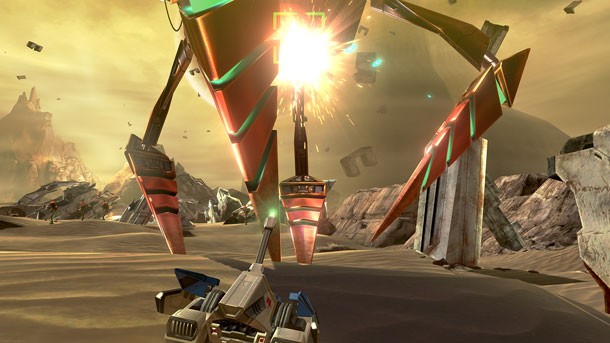
The Arwings can't transform in this instance, but are in "All-Range" mode, a battle stance that moves the wings forward to make them look more like airplanes. This battle concludes with a fight against Pigma, a pig pilot for Andross' army. Hashimoto uses a lock-on technique that allows him to see what's behind Fox's Arwing on the television. The view on the gamepad is still from the cockpit, giving Hashimoto two clear and different viewpoints to use to strategize.
The dogfight is reminiscent of those in the old Wing Commander or Ace Combat games, with plenty of flybys and laser volleys between the foes. Hashimoto eventually takes his opponent down, but doesn't finish the job. A scripted cutscene shows Pigma jetting to safety.
After the demo, Miyamoto tells us that Fox can also pilot the Landmaster, the tank that debuted in Star Fox 64, and a new vehicle called the Gyrowing, a slow-moving helicopter used for stealth operations. The Gyrowing is equipped with a tethered robotic helper called The Direct Eye. This handy little robot is used to navigate small spaces in the environment for switches to open doors or secrets like mysterious gold coins.
Although Star Fox Zero looks retro in design from the visuals on the television screen, it's a much different experience once you get your hands on it. The motion-based targeting system through the gamepad feels a little overwhelming at first. Not only is your attention divided between two screens that are often showing two different views, but you have to use the gamepad's gyroscopic controls to target enemies. The gamepad controls are simple: The left analog stick handles vertical and horizontal movement, while the right analog stick is dedicated to boost, brake, and barrel rolls. The A button is exclusively used for transformations. The right trigger fires the laser and can be held down to initiate the Arwing's signature lock-on blast. The left trigger is used for locking on to targets. Finally, the X button is used in conjunction with the analog stick for somersaults and U-turns.
It took me about half of the Corneria level to truly grasp the control and feel comfortable taking down Andross' forces. There's some guesswork involved in figuring out which screen provides the best view for particular sections, but I had fun experimenting and found I used the gamepad screen more to finely paint targets and better scan the vectors to my left and right.
The final fight against the mothership unfolded differently for me, thanks to Game Informer's eagle-eyed news editor, Mike Futter, who spotted an opening in its hull after one of its sections was blown off. This small gap, barely large enough for the Arwing to fly through, leads down a winding path to a heavily-armed core. Once all of the core's defenses are defeated it explodes, taking out the entire mothership with it.
I also played a level designed exclusively for the Landmaster on a desert planet with gusting winds that send huge chunks of debris everywhere. The Landmaster controls just like it did in Star Fox 64, with the ability to roll and hop. It can also transform into an airborne vehicle for a limited amount of time. The amount of time it can be in flight is clearly shown through a meter on the bottom of the screen.
This stage is filled with falling buildings, plenty of ground-based and aerial targets to defeat, and a boss fight against a giant mechanical sandworm.

The worm gave me a run for my money for roughly 10 to 15 minutes. As it thrashed around and tried to smash my Landmaster, I targeted pulsating hit zones on its sides. This fight is intense, pushing the player to keep tabs on both screens to stay in a safe zone and also in a position to clearly see the targets. Once all of the zones on its body are defeated, the worm opens up and exposes its weak spot.
I struggled to take this foe down, but eventually won with just a sliver of my health left. This brought a round of applause from behind me. I turned to see several Nintendo representatives, including Hiyashi and Hashimoto clapping. My struggle and dance with death clearly became a spectacle. At this point, I handed the gamepad to Mike, who tested out a level designed for the Gyrowing.
This stage is Star Fox's equivalent of stealth. Slow or cautious movement is required to move undetected past search lights, and to deploy the robot to navigate rooms. The Direct Eye's viewpoint is shown on the gamepad. The tether between it and the Gyrowing is roughly 20 feet, which in one instance, forced Mike to lower the Gyrowing to allow more slack for the Direct Eye to reach a switch in a concrete room. After slowly navigating this secure prison-like complex, the demo came to an end.
Mike and I enjoyed what we played of Star Fox Zero. We both struggled with the controls initially, but settled into a nice rhythm about halfway through the levels we played. It has a retro look to it, but is a more complicated Star Fox experience than we've seen before. We'll bring you more impressions of this holiday Wii U release once we get our hands on it again during the E3 week.




